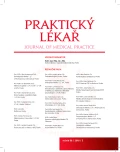Health literacy and the need for community health centres
Authors:
D. Filausová; M. Trešlová
Authors‘ workplace:
Ředitelka: doc. PhDr. Sylva Bártlová, Ph. D.
; Ústav ošetřovatelství, porodní asistence a neodkladné péče
; Děkanka: prof. PhDr. Valérie Tóthová, Ph. D.
; Zdravotně sociální fakulta
; Rektor: doc. Tomáš Machula, Th. D., Ph. D.
; Jihočeská univerzita v Českých Budějovicích
Published in:
Prakt. Lék. 2018; 98(3): 127-130
Category:
Of different specialties
Overview
Introduction:
The paper presents the results of quantitative research, which looked at the level of health literacy in relation to health status, long-term illness, physical activity, visits to the doctor and hospitalization.
Methods:
The data obtained by the HSLQ-EU standardized questionnaire – a total of 251 adults aged 18–70 years old in the Czech Republic, were processed by the SPSS and SASD program, Chi quadrat by the Good Test and the Independence Test.
Results:
Half of people in the sample show only sufficient health literacy. We have found that the lower the health literacy of people, the worse their health, their physical activity is reduced, i.e. they have not practiced or practiced recently. They are also more often hospitalized. We have also found that the number of visits to a doctor does not significantly influence health literacy. We have not demonstrated the link between health literacy by smoking and alcohol use.
Conclusion:
The level of health literacy of the population has an important role to play in the prevention and maintenance of health, thus directly affecting the amount of financial costs of treatment and the complications of the illnesses and subsequent hospitalization..
Keywords:
health literacy – health – illness – physician – hospitalization – activity
Sources
1. Bakker CJ, Koffel JB, Theis-Mahon NR. Measuring the health literacy of Upper Midwest. J Med Libr Assoc 2017; 105(1): 34–43.
2. Betz CL, Ruccione K, Meeske K, et al. Health literacy: a pediatric nursing concern. Pediatr Nurs 2008; 34(3): 231–239.
3. Česká kardiologická společnost. Národní kardiovaskulární program [on line]. Dostupné z: http://www.kardio-cz.cz/data/clanek/604/dokumenty/narodni-kardiovaskularni-program.pdf [cit. 2017-12-05].
4. Český statistický úřad. Střední délka života se zvyšuje [on line]. Dostupné z: https://www.czso.cz/csu/xj/stredni-delka-zivota-se-zvysuje [cit. 2017-12-05].
5. Dart MA. Motivational interviewing in nursing practice. Sadbury Massachusetts: Jones and Bartlett Publishers 2011.
6. Holčík J. Systém péče o zdraví a zdravotní gramotnost: k teoretickým základům cesty ke zdraví. Brno: Masarykova univerzita 2010.
7. Kolarcik P, Cepova E, Madarasova Geckova A, et al. Structural properties and psychometric improvements of health literacy questionnaire in Slovak population. Int J Public Health 2017; 62(5): 591–604.
8. Krausová A. Odpovědnost za vlastní zdravotní stav [online]. 2013-10-24 Dostupné z: https://zdravotnickepravo.info/odpovednost-za-vlastni-zdravotni-stav/ [cit. 2017-12-05].
9. Kučera Z. Výzkum: Češi neumějí hledat a správně chápat informace o zdraví. Medical Tribune CZ [on line]. Dostupné z: https://www.tribune.cz/clanek/36042-vyzkum-cesi-neumeji-hledat-a-spravne-chapat-informace-o-zdravi [cit. 2017-10-09].
10. Machová J, Kubátová D, a kol. Výchova ke zdraví. 2. aktualizované vydání. Praha: Grada Publishing 2016.
11. Mandysová P. Příprava na edukaci v ošetřovatelství. Pardubice: Univerzita Pardubice, Fakulta zdravotnických studií 2016.
12. Marková M. Determinanty zdraví. Brno: Národní centrum ošetřovatelství a nelékařských zdravotnických oborů 2012.
13. Ministerstvo zdravotnictví ČR. Zdraví 2020. Národní strategie ochrany a podpory zdraví a prevence nemocí. Akční plán č. 12: Rozvoj zdravotní gramotnosti na období 2015–2020 [online]. Dostupné z: http://www.mzcr.cz/Admin/_upload/files/5/ akční plány - přílohy/AP 12 rozvoj zdravotní gramotnosti.pdf [cit. 2017-12-05].
14. Nielsen-Bohlman L, Panzer AM, Kinding DA (eds.). Health literacy: a prescription of end confusion. Washington, DC: National Academies Press 2004.
15. Saffi MA, Polanczyk CA, Rabelo-Silva ER. Lifestyle interventions reduce cardiovascular risk in patients with coronary artery disease: A randomized clinical trial. Eur J Cardiovasc Nurs 2014; 13(5): 436–443.
16. Sørensen K, van den Broucke S, Fullam J, et al. Health literacy and public health: a systematic review and integration of definitions and models. BMC Public Health 2012; 12 : 80.
17. Špirudová L. Doprovázení v ošetřovatelství I: Pomáhající profese, doprovázení a systém podpory pro pacienty. Praha: Grada Publishing 2015.
18. Tóthová V, Bártlová S, Šedová L, et al. The nurse’s role in preventive care in the field of community nursing. Neuro Endocrinol Lett. 2014; 35(Suppl 1): 26–33.
19. World Health Organization. Global recommendations on physical activity for health. Geneva: WHO Press, 2010. Dostupné z: http://apps.who.int/iris/bitstream/10665/44399/1/9789241599979_eng.pdf. [cit. 2017-12-05].
Labels
General practitioner for children and adolescents General practitioner for adultsArticle was published in
General Practitioner

2018 Issue 3
- Advances in the Treatment of Myasthenia Gravis on the Horizon
- What Effect Can Be Expected from Limosilactobacillus reuteri in Mucositis and Peri-Implantitis?
- Memantine Eases Daily Life for Patients and Caregivers
- Metamizole vs. Tramadol in Postoperative Analgesia
Most read in this issue
- Preoperative anaemia: prevalence, causes, consequences, and management
- Overview of questionnaires and scales of the motor symptoms of patients with Parkinson’s disease
- Treatment of immunodeficiency by subcutaneous immunoglobulins
- Basics of respiratory physiotherapy for general practitioners
